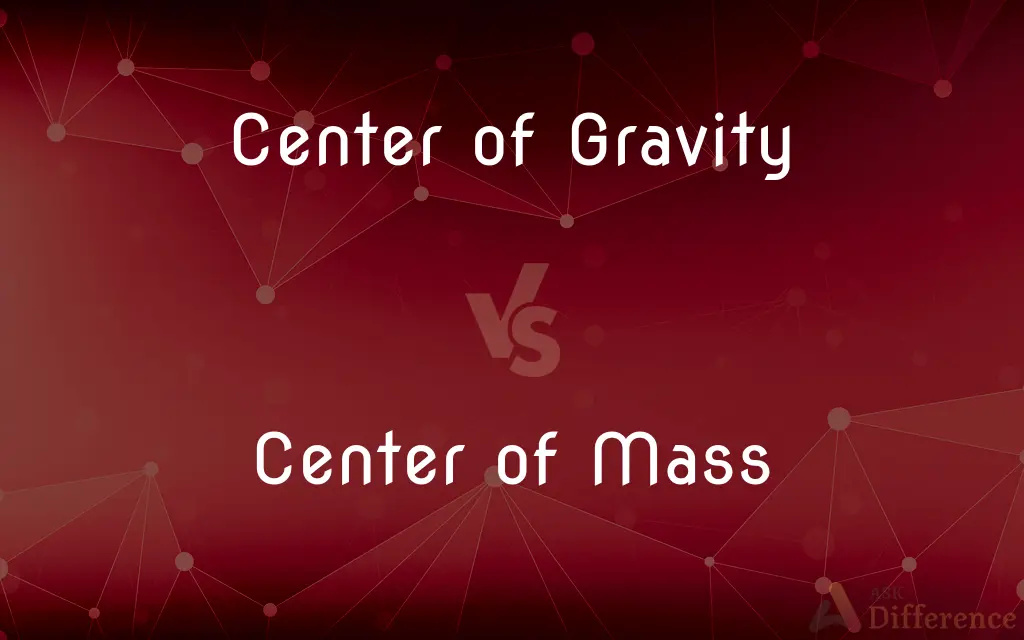Center of Gravity vs. Center of Mass — What's the Difference?
By Tayyaba Rehman — Published on November 13, 2023
Center of Gravity is the point where the gravitational force acts, while Center of Mass is the average location of all the mass in a system.

Difference Between Center of Gravity and Center of Mass
Table of Contents
ADVERTISEMENT
Key Differences
Center of Gravity and Center of Mass are concepts that often arise in the study of physics and mechanics. At first glance, they might seem like identical terms. However, subtle differences set them apart. The Center of Gravity is specifically the point on an object where the total gravitational force exerted on the body acts. This point can shift depending on external factors like the gravitational field.
In contrast, the Center of Mass refers to the average location of all the mass in a system or body. It doesn't change due to external forces like gravity, unless the distribution of mass within the object itself changes. Think of it as the balancing point of an object if gravity were acting uniformly across it.
For many situations, especially in a uniform gravitational field like on Earth's surface, the Center of Gravity and the Center of Mass coincide, making them seem synonymous. However, in non-uniform gravitational fields, these points might differ. For instance, a large object in space, subject to varying gravitational pulls from different celestial bodies, might have distinct centers of gravity and mass.
Moreover, while Center of Mass is a concept that is always defined for any object or system of particles, the Center of Gravity is only relevant in the presence of a gravitational field. It's the interaction with this field that differentiates these two centers.
Understanding both the Center of Gravity and the Center of Mass is crucial in various fields, from designing vehicles for balance and stability to understanding celestial mechanics. While they may often overlap, each offers a unique perspective on the distribution and effect of mass in a system or object.
ADVERTISEMENT
Comparison Chart
Definition
Point where gravitational force acts
Average location of all mass in a system
Dependency
Depends on the gravitational field
Independent of external forces
Changes
Can change with varying gravitational fields
Remains constant unless mass distribution changes
Relevance
Only in the presence of a gravitational field
Always defined for any object or system
Overlap
Often coincides with Center of Mass on Earth's surface
Can be different from Center of Gravity in non-uniform fields
Compare with Definitions
Center of Gravity
Relevant only in the presence of a gravitational field.
Without gravitational influences, discussing the center of gravity is moot.
Center of Mass
The average location of all the mass in a system.
The center of mass of a frisbee is its geometrical center.
Center of Gravity
The effective point of weight due to gravitational pull.
Engineers determine the center of gravity of cars for optimal stability.
Center of Mass
Point that remains consistent unless mass distribution changes.
Cutting a section of a rod shifts its center of mass.
Center of Gravity
Location where total gravitational force is applied.
Shifting the center of gravity can affect an object's stability.
Center of Mass
Always defined, regardless of external forces.
Even in outer space, objects have a defined center of mass.
Center of Gravity
Point that varies with external gravitational fields.
In varying gravitational fields, an object's center of gravity may not match its center of mass.
Center of Mass
Balancing point if gravity acted uniformly.
The center of mass of a seesaw is where it balances without tilting.
Center of Gravity
The point on an object where gravity acts.
The center of gravity of a pendulum determines its period of oscillation.
Center of Mass
A concept used to understand distribution of mass.
Knowing the center of mass helps in analyzing motion in physics.
Common Curiosities
Can the center of gravity and center of mass differ?
Yes, especially in non-uniform gravitational fields, the two can be distinct.
How is the center of mass defined?
The center of mass is the average location of all the mass in a system or body.
Is the center of mass always present?
Yes, every object or system has a defined center of mass regardless of external forces.
Are the two concepts synonymous on Earth?
Often on Earth's surface, due to a uniform gravitational field, the center of gravity and center of mass coincide.
How do engineers use the concept of center of gravity?
Engineers consider the center of gravity for design, stability, and safety in structures and vehicles.
What is the center of gravity in simple terms?
The center of gravity is the point on an object where the total gravitational force acts.
Can altering an object's mass distribution change its center of mass?
Yes, redistributing mass in an object will change its center of mass.
How does gravity affect the center of gravity?
The center of gravity shifts based on the gravitational field it's in.
Why is the center of mass important in physics?
It's crucial for understanding the motion, rotation, and behavior of objects.
Is the center of gravity always within the physical bounds of an object?
No, for some objects, like a horseshoe, the center of gravity can lie outside the object.
What happens to an object's center of gravity in space?
In space, with varied gravitational influences, the center of gravity might differ from the center of mass.
Does the shape of an object affect its center of mass?
Yes, the distribution of mass determines the center of mass, so shape plays a role.
How can you experimentally determine the center of mass?
By balancing or suspending an object, you can find its center of mass as the balance point.
Why is understanding these centers important in sports?
Athletes and trainers use the principles to optimize performance, balance, and stability.
How are the concepts applied in astronomy?
They help in understanding planetary motion, star formation, and behavior of celestial bodies.
Share Your Discovery

Previous Comparison
Reality vs. Dreams
Next Comparison
Early Man vs. Modern ManAuthor Spotlight
Written by
Tayyaba RehmanTayyaba Rehman is a distinguished writer, currently serving as a primary contributor to askdifference.com. As a researcher in semantics and etymology, Tayyaba's passion for the complexity of languages and their distinctions has found a perfect home on the platform. Tayyaba delves into the intricacies of language, distinguishing between commonly confused words and phrases, thereby providing clarity for readers worldwide.
















































